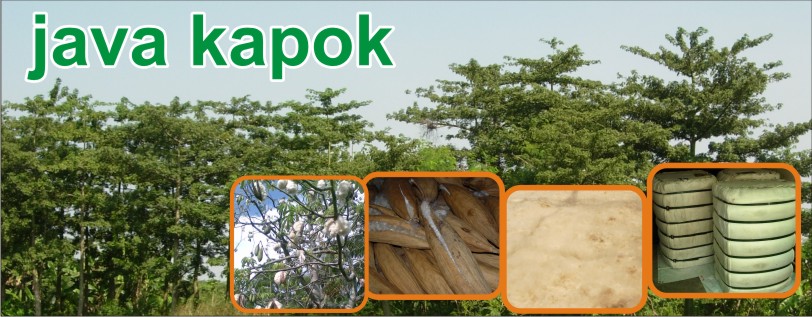Total Tayangan Halaman
Kamis, 01 Desember 2011
New Improvement of Our Kapok Fiber Will Be Coming Up !
Selasa, 08 November 2011
Utilization of kapok waste
Sabtu, 29 Oktober 2011
Let's Save The Earth From Global Warming !
Potential of Kapok Fibre as a Substitute of Cotton in Textiles
Kamis, 06 Oktober 2011
Now is the best time to purchase kapok fiber !!!
Kamis, 29 September 2011
Wow..!!! Daun kapok bisa digunakan untuk membuat Oli?
Sabtu, 17 September 2011
Ceiba Petandra
Ceiba pentandra is a tropical tree of the order Malvales and the family Malvaceae (previously separated in the family Bombacaceae), native to Mexico, Central America and the Caribbean, northern South America, and (as the variety C. pentandra var. guineensis) to tropical west Africa. Kapok is the most used common name for the tree and may also refer to the fibre obtained from its seed pods. The tree is also known as the Java cotton, Java kapok, Silk cotton or ceiba. It is a sacred symbol in Maya mythology.
The tree grows to 60-70 m (200-230 ft) tall and has a very substantial trunk up to 3 m (10 ft) in diameter with buttresses. The trunk and many of the larger branches are often (but not always) crowded with very large, robust simple thorns. The leaves are compound of 5 to 9 leaflets, each up to 20 cm (8 in) and palm like. Adult trees produce several hundred 15 cm (6 in) seed pods. The pods contain seeds surrounded by a fluffy, yellowish fibre that is a mix of lignin and cellulose.
Uses
The fibre is light, very buoyant, resilient and resistant to water. The process of harvesting and separating the fibre is labour-intensive and manual. It is difficult to spin but is used as an alternative to down as filling in mattresses, pillows, upholstery, zafus, and stuffed toys such as teddy bears, and for insulation. It was previously much used in life jackets and similar devices until synthetic materials largely replaced the fibre. The seeds produce an oil used locally in soap and that can be used as fertilizer.
Native tribes along the Amazon River harvest the kapok fibre to wrap around their blowgun darts. The fibres create a seal that allows the pressure to force the dart through the tube.
The commercial tree is most heavily cultivated in the rainforests of Asia, notably in Java (hence its nicknames), Philippines, Malaysia, Hainan Island in China as well as in South America.
The flowers are an important source of nectar and pollen for honeybees.
This tree is the official national tree of Puerto Rico and Guatemala.[citation needed]
Ethnomedical uses
Ceiba pentandra bark decoction has been used as a diuretic, aphrodisiac, and to treat headache, as well as type II diabetes.
Ceiba pentandra is used as an additive to some versions of the hallucinogenic drink Ayahuasca.
Sumber : wikipedia.org
Selasa, 06 September 2011
Details for Untilizing Kapok Fiber As Sound Absorption Material
Description :
Serat alam yang mempunyai berbagai sifat unggul, diantaranya adalah: ringan, lembut, dan mudah dibentuk. Tujuan dari penelitian ini adalah, memanfaatkan Serat Kapok untuk bahan penyerap suara,baik yang ditujukan untuk mengurangi energi refleksi suara (dengung), maupun untuk mengurangi transmisi energi energi suara dari dalam ke luar ruangan, atau sebaliknya.Telah dibuat penyerap suara terbuat darai serat kapok urai dengan rapat massa 16 kg/m3 , yang dimasukkan ke dalam kantong tekstil, dengan ukuran 1,2 x 1,2 m2 , dan tebal 5 cm; dan hasilnya telah diuji. Bahan tersebut mampu menyerap energi suara yang jatuh pada permukaannya. Kantong peredam tersebut dibuat 9 buah, untuk memenuhi persyaratan pengujian dalam ruang uji akustik,yaitu luas minima1 10 m2. Sebagai pembanding adalah glass wool dengan rapat masa dan dimensi yang sama. Hasilnya menunjukan bahwa pada frekuensi rendah yaitu 150 - 800 Hz koefien absorbsi acak (random) arkp lebih tinggi lebih tinggi dari pada glass wool (argw), sementara pada frekuensi tinggi diatas 800 Hz hingga 4 kHz, arkp sedikit lebih rendah dari argw (lihat grafik koefisien alfa random).Juga telah dibuat panel serat kapok dengan dimensi 69 x 69 cm2, dengan tebal 2,5 cm, dan rapat masa 100 kg/m3 dan 200 kg/m3. Panel-panel tersebut digunakan sebagai sampel uji Transmission Loss (TL) energi suara untuk mendapatkan Sound Tranmission Class (STC). Pengjian yang sama juga dikakukan pada kapok urai, dan glass wool yang dimasukkan ke dalam kotak tripleks berukuran 69 x 69 cm2 dan tebal 5 cm, sebagai pembanding. Pengujian menghasilkan nilai STC Panel Kapok dengan rapat masa 200 kg/m3 adalah 21, sedang untuk panel Kapok dengan rapat masa 100 kg/m3adalah 19. Sementara nilai STC untuk untuk Kapok urai dalam kotak tripleks adalah 22, dan untuk glass wool adalah 21.Dari hasil penelitian ini dapat disimpulkan bahwa serat Kapok dapat digunakan sebagai bahan penyerap suara untuk mengontrol kualitas akustik dalam suatu ruangan auditorium atau ruang penumpang dalam mobil.
Sumber : http://yogya.litbang.deptan.go.id
Senin, 05 September 2011
Export Project
 Kapok fiber is a natural fibers which is very useful for various applications. There will be a great demand of it in the future since its environmental friendly property. The problem is kapok tree only grows at tropical countries such as Indonesia. So that other countries where kapok fiber is unavailable and need kapok fiber at the same, they have to import it from kapok exporting countries such as Indonesia.
Kapok fiber is a natural fibers which is very useful for various applications. There will be a great demand of it in the future since its environmental friendly property. The problem is kapok tree only grows at tropical countries such as Indonesia. So that other countries where kapok fiber is unavailable and need kapok fiber at the same, they have to import it from kapok exporting countries such as Indonesia.

